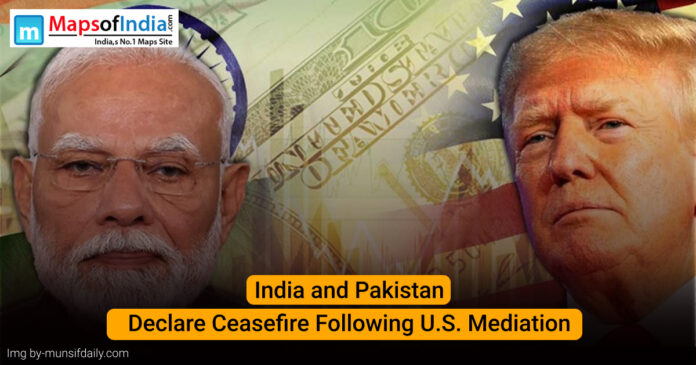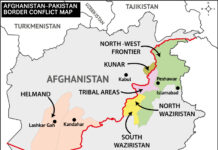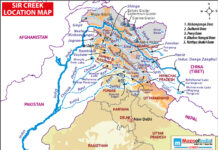
In a significant diplomatic breakthrough, India and Pakistan have agreed to a full and immediate ceasefire, effectively halting the most intense military escalation between the two nuclear-armed neighbors in decades. The agreement, announced on May 10, 2025, follows intensive overnight negotiations mediated by the United States, with additional support from Saudi Arabia and Turkey.
Background: The Pahalgam Attack and Escalation
The recent hostilities were triggered by a terrorist attack on April 22, 2025, in Pahalgam, Indian-administered Kashmir, where 26 Hindu tourists were killed and over 20 injured. The Resistance Front (TRF), believed to be an offshoot of the Pakistan-based Lashkar-e-Taiba, claimed responsibility. India accused Pakistan of harboring the perpetrators, citing digital evidence linking the attackers to safe houses in Muzaffarabad and Karachi.
In response, India launched “Operation Sindoor” on May 7, targeting alleged terrorist infrastructure in Pakistan and Pakistani-administered Kashmir. The operation involved missile strikes by Rafale jets equipped with SCALP missiles and AASM Hammer bombs, targeting locations including Bahawalpur and Muridke. India claimed the strikes were “focused, measured, and non-escalatory,” aiming to dismantle terrorist camps without targeting Pakistani military facilities.
Pakistan retaliated with drone and missile strikes across several Indian cities, including Amritsar. India reported intercepting these attacks using its S-400 missile defense system. The ensuing conflict saw the downing of aircraft on both sides and significant civilian casualties, marking one of the most intense confrontations since the Kargil War.
Pakistan’s Retaliation and Further Escalation
Pakistan responded with drone and missile strikes on Indian military installations and urban centers including Amritsar, Pathankot, and Jammu. While India’s S-400 missile defense system intercepted many incoming projectiles, the confrontation led to casualties on both sides.
The two nations appeared to be on the brink of a full-scale war. Indian sources claimed to have shot down a Pakistani F-16 jet near the Rajasthan border, while Pakistan’s military alleged damage to Indian forward posts.
As tensions escalated, both countries moved troops closer to the border, suspended diplomatic missions, and halted trade and transportation links. Civil defense measures were initiated in major Indian cities, with air raid sirens being tested and underground shelters being prepped for civilian use.
Diplomatic Fallout and India’s Measures
In the wake of the Pahalgam attack, India undertook several diplomatic and strategic measures:
- Suspension of the Indus Waters Treaty: On April 23, India suspended the Indus Waters Treaty, citing national security concerns. This move led to a significant reduction in water flow through the Chenab River into Pakistan, prompting Islamabad to accuse India of weaponizing water resources.
- Diplomatic Downgrades: India expelled Pakistani military advisers from its High Commission in New Delhi and reduced its diplomatic staff in Islamabad. Visa services for Pakistani nationals were suspended, and the Attari–Wagah border check post was closed.
- Civil Defense Preparations: The Indian Ministry of Home Affairs initiated civil defense drills across seven states, including the operationalization of air raid warning systems and evacuation plans, reminiscent of measures last seen during the 1971 war.
International Mediation and Ceasefire Agreement
The escalating conflict drew international concern, prompting mediation efforts led by the United States. President Donald Trump announced the ceasefire agreement, praising the leadership of both nations for prioritizing diplomacy. The ceasefire, effective from 4:30 p.m. IST on May 10, was also facilitated by diplomatic efforts from Saudi Arabia and Turkey.
Both India and Pakistan have agreed to commence discussions on a wide range of issues at a neutral location, signaling a commitment to de-escalation and conflict resolution.
Key Conditions Imposed by India
India entered the negotiations with a strong strategic position and presented a list of non-negotiable conditions that were incorporated into the ceasefire agreement. These include:
1. Zero Tolerance for Cross-Border Terrorism
India demanded that Pakistan must completely dismantle all terrorist camps and prevent any cross-border infiltration into Jammu and Kashmir. It has insisted that any support, logistical or ideological, to groups like Lashkar-e-Taiba, Jaish-e-Mohammed, or TRF would be treated as a direct violation of the ceasefire.
2. Declaration of Terror Acts as Acts of War
Perhaps the most critical clause India included is a new red-line doctrine:
“Any future terror attack on Indian soil, directly or indirectly linked to Pakistan, will be considered an act of war.”
This statement was made officially by India’s External Affairs Minister S. Jaishankar and later reiterated by Defense Minister Rajnath Singh. It signals a monumental shift in India’s security posture, equating non-state terrorism with conventional warfare if supported or sheltered by Pakistan.
3. Uninterrupted Monitoring
India has called for continuous international monitoring of terror activity in Pakistan through third-party intelligence cooperation involving the U.S., France, and UAE.
4. No Diplomatic Normalization Without Proof of Compliance
New Delhi has clarified that normalization of diplomatic ties will only resume once Pakistan demonstrates verifiable action against terrorism. There will be no high-level visits or resumption of trade until India’s security conditions are met.
Pakistan’s Position and Response
While agreeing to the ceasefire, Pakistan has called for an independent international investigation into the Pahalgam attack, accusing India of using it as a pretext for aggression. Islamabad has also denied harboring terrorists and has termed India’s strikes as violations of its sovereignty.
Prime Minister Shehbaz Sharif has expressed conditional support for the ceasefire and emphasized the need for resolving the Kashmir dispute through dialogue, a position India has dismissed as irrelevant until terrorism is addressed.
International Reactions
The ceasefire has been welcomed globally:
- United Nations: UN Secretary-General António Guterres described the agreement as a “positive step” towards peace and stability in South Asia.
- United States: President Trump and Secretary of State Marco Rubio commended both nations for their decision, emphasizing the importance of diplomacy and restraint.
- Other Nations: Countries including Saudi Arabia, Turkey, and members of the G7 have expressed support for the ceasefire and urged both nations to engage in sustained dialogue to resolve underlying issues.
Challenges to Long-Term Peace
While the ceasefire has halted active hostilities, experts warn that underlying issues remain unresolved:
- Kashmir remains a contentious issue, with Pakistan calling for demilitarization, and India emphasizing internal law and order.
- Terrorism remains the biggest hurdle. Unless Pakistan takes visible steps to dismantle terrorist networks, the truce may be short-lived.
- Trust deficit between the two countries is at an all-time high. There’s fear that one provocation could undo the fragile peace.
Conclusion
The India-Pakistan ceasefire of May 2025 is a much-needed pause in one of the world’s most dangerous flashpoints. While it brings relief from immediate bloodshed, long-term peace hinges on the ability of both nations to address the root causes of conflict—primarily, cross-border terrorism.
India’s uncompromising stand that any future terror act will be considered an act of war has redefined the rules of engagement. It sets a precedent that peace is not merely the absence of war, but the absence of terror.
Whether this truce evolves into a permanent peace or collapses under the weight of mistrust will depend on what Pakistan does next.



